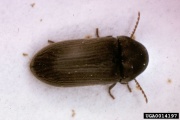Difference between revisions of "Deathwatch beetle"
Jump to navigation
Jump to search
(username removed) |
m (Text replace - "== Authority ==" to "== Sources Checked for Data in Record ==") |
||
| Line 10: | Line 10: | ||
Death Watch beetle; woodboring beetle; Xestobium rufovillosum | Death Watch beetle; woodboring beetle; Xestobium rufovillosum | ||
| − | == | + | == Sources Checked for Data in Record == |
* Hermann Kuhn, ''Conservation and Restoration of Works of Art and Antiquities'', Butterworths, London, 1986 | * Hermann Kuhn, ''Conservation and Restoration of Works of Art and Antiquities'', Butterworths, London, 1986 | ||
Revision as of 19:26, 30 April 2016
Description
A beetle (Xestobium rufovillosum) from the family Anobiidae. Both the deathwatch beetle adults and larvae burrow through wood in furniture, sculpture, and buildings. The adult insect is small (3-9 mm long) with a dark brown to black shell. The male deathwatch beetle produces a ticking sound by striking his head against the wood. The sound, once believed to be an omen of death, is used as a mating call while the beetle bores his way out during the summer. Its life cycle is usually 1 year but can live up to 3 years.
Synonyms and Related Terms
Death Watch beetle; woodboring beetle; Xestobium rufovillosum
Sources Checked for Data in Record
- Hermann Kuhn, Conservation and Restoration of Works of Art and Antiquities, Butterworths, London, 1986
- Encyclopedia Britannica, http://www.britannica.com Comment: "deathwatch beetle." Encyclopædia Britannica. 2004. Encyclopædia Britannica Premium Service. 16 Nov. 2004 .
- Random House, Webster's Encyclopedic Unabridged Dictionary of the English Language, Grammercy Book, New York, 1997
- The American Heritage Dictionary or Encarta, via Microsoft Bookshelf 98, Microsoft Corp., 1998
